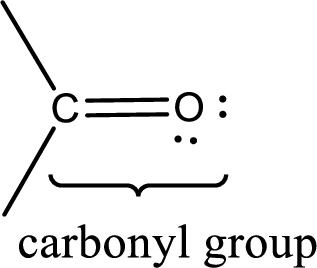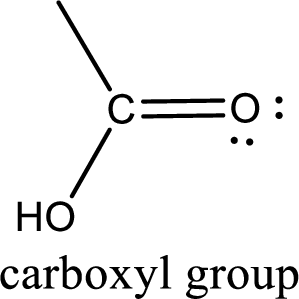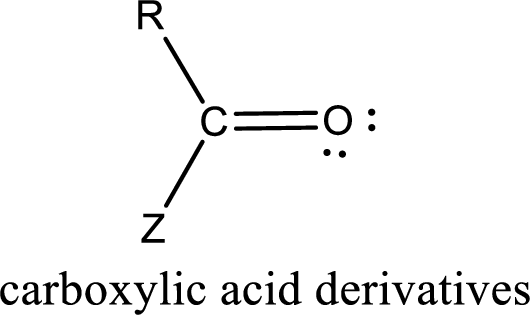
Organic And Biological Chemistry
7th Edition
ISBN: 9781305638686
Author: H. Stephen Stoker
Publisher: Brooks Cole
expand_more
expand_more
format_list_bulleted
Question
Chapter 5, Problem 5.78EP
Interpretation Introduction
Interpretation:
Two linear notations for the ester
Concept Introduction:
Carbonyl groups are the one which contain a double bond between carbon and oxygen atom.

If a hydroxyl group is attached to a carbonyl group means it is known as carboxyl group. This can be represented as shown below,


Expert Solution & Answer
Want to see the full answer?
Check out a sample textbook solution
Students have asked these similar questions
V
Consider this step in a radical reaction:
Br:
?
What type of step is this? Check all that apply.
Draw the products of the step on the right-hand side of the drawing area
below. If more than one set of products is possible, draw any set.
Also, draw the mechanism arrows on the left-hand side of the drawing
area to show how this happens.
⚫ionization
termination
initialization
neutralization
none of the abc
Explanation
Check
80
Ο
F3
F1
F2
2
F4
01
%
do5
$
94
#3
X
5
C
MacBook Air
25
F5
F6
66
©2025
ˇ
F7
29
&
7
8
Show how to convert ethyl benzene to (a) 2,5-dichlorobenzoic acid and (b) 2,4-dichlorobenzoic acid.
no ai
Chapter 5 Solutions
Organic And Biological Chemistry
Ch. 5.1 - Prob. 1QQCh. 5.1 - Prob. 2QQCh. 5.1 - Prob. 3QQCh. 5.1 - Prob. 4QQCh. 5.1 - Prob. 5QQCh. 5.2 - Prob. 1QQCh. 5.2 - Prob. 2QQCh. 5.2 - Prob. 3QQCh. 5.2 - Prob. 4QQCh. 5.2 - Prob. 5QQ
Ch. 5.3 - Prob. 1QQCh. 5.3 - Prob. 2QQCh. 5.3 - Prob. 3QQCh. 5.4 - Prob. 1QQCh. 5.4 - Prob. 2QQCh. 5.4 - Prob. 3QQCh. 5.5 - Prob. 1QQCh. 5.5 - Prob. 2QQCh. 5.5 - Prob. 3QQCh. 5.6 - Prob. 1QQCh. 5.6 - Prob. 2QQCh. 5.7 - Which of the following statements about acid...Ch. 5.7 - Prob. 2QQCh. 5.7 - Prob. 3QQCh. 5.8 - Prob. 1QQCh. 5.8 - Prob. 2QQCh. 5.8 - Prob. 3QQCh. 5.8 - Prob. 4QQCh. 5.9 - Prob. 1QQCh. 5.9 - Prob. 2QQCh. 5.10 - Prob. 1QQCh. 5.10 - Prob. 2QQCh. 5.11 - Prob. 1QQCh. 5.11 - Prob. 2QQCh. 5.11 - Prob. 3QQCh. 5.12 - Prob. 1QQCh. 5.12 - Prob. 2QQCh. 5.12 - Prob. 3QQCh. 5.12 - Prob. 4QQCh. 5.13 - Prob. 1QQCh. 5.13 - Prob. 2QQCh. 5.14 - Prob. 1QQCh. 5.14 - Prob. 2QQCh. 5.14 - Prob. 3QQCh. 5.15 - Prob. 1QQCh. 5.15 - Prob. 2QQCh. 5.15 - Prob. 3QQCh. 5.16 - Prob. 1QQCh. 5.16 - Prob. 2QQCh. 5.16 - Prob. 3QQCh. 5.17 - Prob. 1QQCh. 5.17 - Prob. 2QQCh. 5.18 - Prob. 1QQCh. 5.18 - Prob. 2QQCh. 5.18 - Prob. 3QQCh. 5.19 - Prob. 1QQCh. 5.19 - Prob. 2QQCh. 5.19 - Prob. 3QQCh. 5.19 - Prob. 4QQCh. 5.20 - Prob. 1QQCh. 5.20 - Prob. 2QQCh. 5.20 - Prob. 3QQCh. 5.20 - Prob. 4QQCh. 5 - Prob. 5.1EPCh. 5 - Prob. 5.2EPCh. 5 - Prob. 5.3EPCh. 5 - Indicate whether or not each of the compounds in...Ch. 5 - Prob. 5.5EPCh. 5 - Prob. 5.6EPCh. 5 - Prob. 5.7EPCh. 5 - Prob. 5.8EPCh. 5 - Prob. 5.9EPCh. 5 - Prob. 5.10EPCh. 5 - Prob. 5.11EPCh. 5 - Prob. 5.12EPCh. 5 - Prob. 5.13EPCh. 5 - Prob. 5.14EPCh. 5 - Prob. 5.15EPCh. 5 - Assign an IUPAC name to each of the following...Ch. 5 - Prob. 5.17EPCh. 5 - Prob. 5.18EPCh. 5 - Prob. 5.19EPCh. 5 - Prob. 5.20EPCh. 5 - Prob. 5.21EPCh. 5 - Prob. 5.22EPCh. 5 - Prob. 5.23EPCh. 5 - Prob. 5.24EPCh. 5 - Prob. 5.25EPCh. 5 - Prob. 5.26EPCh. 5 - Prob. 5.27EPCh. 5 - Prob. 5.28EPCh. 5 - Prob. 5.29EPCh. 5 - Prob. 5.30EPCh. 5 - Prob. 5.31EPCh. 5 - Prob. 5.32EPCh. 5 - Prob. 5.33EPCh. 5 - Prob. 5.34EPCh. 5 - Prob. 5.35EPCh. 5 - Prob. 5.36EPCh. 5 - Prob. 5.37EPCh. 5 - Prob. 5.38EPCh. 5 - Prob. 5.39EPCh. 5 - Prob. 5.40EPCh. 5 - Determine the maximum number of hydrogen bonds...Ch. 5 - Prob. 5.42EPCh. 5 - Prob. 5.43EPCh. 5 - Prob. 5.44EPCh. 5 - Prob. 5.45EPCh. 5 - Prob. 5.46EPCh. 5 - Prob. 5.47EPCh. 5 - Prob. 5.48EPCh. 5 - Prob. 5.49EPCh. 5 - Prob. 5.50EPCh. 5 - Prob. 5.51EPCh. 5 - Prob. 5.52EPCh. 5 - Prob. 5.53EPCh. 5 - Prob. 5.54EPCh. 5 - Draw structural formulas for the following...Ch. 5 - Prob. 5.56EPCh. 5 - Give the IUPAC name for each of the following...Ch. 5 - Give the IUPAC name for each of the following...Ch. 5 - Prob. 5.59EPCh. 5 - Prob. 5.60EPCh. 5 - Prob. 5.61EPCh. 5 - Prob. 5.62EPCh. 5 - Prob. 5.63EPCh. 5 - Prob. 5.64EPCh. 5 - Prob. 5.65EPCh. 5 - Which three carboxylic acids have salts that are...Ch. 5 - Prob. 5.67EPCh. 5 - Which carboxylic acid has salts that are used to...Ch. 5 - Prob. 5.69EPCh. 5 - Prob. 5.70EPCh. 5 - Prob. 5.71EPCh. 5 - Prob. 5.72EPCh. 5 - Prob. 5.73EPCh. 5 - Prob. 5.74EPCh. 5 - Prob. 5.75EPCh. 5 - Prob. 5.76EPCh. 5 - Prob. 5.77EPCh. 5 - Prob. 5.78EPCh. 5 - Prob. 5.79EPCh. 5 - Prob. 5.80EPCh. 5 - Prob. 5.81EPCh. 5 - Prob. 5.82EPCh. 5 - Prob. 5.83EPCh. 5 - Prob. 5.84EPCh. 5 - Prob. 5.85EPCh. 5 - Prob. 5.86EPCh. 5 - Prob. 5.87EPCh. 5 - Prob. 5.88EPCh. 5 - Prob. 5.89EPCh. 5 - Prob. 5.90EPCh. 5 - Assign common names to each of the esters in...Ch. 5 - Prob. 5.92EPCh. 5 - Prob. 5.93EPCh. 5 - Assign an IUPAC name to each of the following...Ch. 5 - Draw a structural formula for each of the...Ch. 5 - Prob. 5.96EPCh. 5 - Prob. 5.97EPCh. 5 - Prob. 5.98EPCh. 5 - Prob. 5.99EPCh. 5 - Prob. 5.100EPCh. 5 - Prob. 5.101EPCh. 5 - How many carbon atoms are present in a molecule of...Ch. 5 - Prob. 5.103EPCh. 5 - Prob. 5.104EPCh. 5 - Prob. 5.105EPCh. 5 - Prob. 5.106EPCh. 5 - Prob. 5.107EPCh. 5 - Prob. 5.108EPCh. 5 - Prob. 5.109EPCh. 5 - Prob. 5.110EPCh. 5 - Prob. 5.111EPCh. 5 - Prob. 5.112EPCh. 5 - Prob. 5.113EPCh. 5 - Prob. 5.114EPCh. 5 - Prob. 5.115EPCh. 5 - Prob. 5.116EPCh. 5 - Prob. 5.117EPCh. 5 - Prob. 5.118EPCh. 5 - Prob. 5.119EPCh. 5 - Prob. 5.120EPCh. 5 - Prob. 5.121EPCh. 5 - Prob. 5.122EPCh. 5 - Prob. 5.123EPCh. 5 - Prob. 5.124EPCh. 5 - Write the structural formulas of the reaction...Ch. 5 - Prob. 5.126EPCh. 5 - Prob. 5.127EPCh. 5 - Prob. 5.128EPCh. 5 - Prob. 5.129EPCh. 5 - Prob. 5.130EPCh. 5 - Prob. 5.131EPCh. 5 - Prob. 5.132EPCh. 5 - Prob. 5.133EPCh. 5 - Prob. 5.134EPCh. 5 - Prob. 5.135EPCh. 5 - Prob. 5.136EPCh. 5 - Prob. 5.137EPCh. 5 - Prob. 5.138EPCh. 5 - Prob. 5.139EPCh. 5 - Prob. 5.140EPCh. 5 - Prob. 5.141EPCh. 5 - Prob. 5.142EPCh. 5 - Prob. 5.143EPCh. 5 - Prob. 5.144EPCh. 5 - Prob. 5.145EPCh. 5 - Prob. 5.146EPCh. 5 - Prob. 5.147EPCh. 5 - Prob. 5.148EPCh. 5 - Draw a condensed structural formula for the...Ch. 5 - Draw a condensed structural formula for the...Ch. 5 - Prob. 5.151EPCh. 5 - Prob. 5.152EPCh. 5 - Prob. 5.153EPCh. 5 - Prob. 5.154EPCh. 5 - Prob. 5.155EPCh. 5 - Prob. 5.156EPCh. 5 - Prob. 5.157EPCh. 5 - Prob. 5.158EPCh. 5 - Prob. 5.159EPCh. 5 - Prob. 5.160EPCh. 5 - Prob. 5.161EPCh. 5 - Prob. 5.162EPCh. 5 - Prob. 5.163EPCh. 5 - Prob. 5.164EP
Knowledge Booster
Similar questions
- Polymers may be composed of thousands of monomers. Draw three repeat units (trimer) of the polymer formed in this reaction. Assume there are hydrogen atoms there are hydrogen atoms on the two ends of the trimer. Ignore inorganic byproducts.arrow_forwardDraw a tetramer if this alternating copolymer pleasearrow_forwardDraw the monomers required to synthesize this condensation polymer.arrow_forward
- Draw the monomers required to synthesize this condensation polymer.arrow_forward8:44 PM Sun Apr 13 Earn Freecash.com O Measurement and Matter =1 Setting up a unit conversion 110 Eddie says... ✰ www-awu.aleks.com A student sets up the following equation to convert a measurement. (The ? stands for a number the student is going to calculate.) Fill in the missing part of this equation. Note: your answer should be in the form of one or more fractions multiplied together. (- 4 J kJ -7.0 × 10 ☐ = ? mmol.°C mol °C x10 μ Explanation Check □·□ torox.io Grey Hill LLC. All Rightsarrow_forwardPolymers may be composed of thousands of monomers. Draw three repeat units (trimer) of the polymer formed in this reaction. Assume there are hydrogen atoms there are hydrogen atoms on the two ends of the trimer. Ignore inorganic byproducts please.arrow_forward
- i need help on how to complete the followingarrow_forwardno AI walkthrough current image is wrong answerarrow_forwarda. Determine whether each of the Followery Molecules is in the R- On the y- Configuration 1-01"/ 1-6-4 Br 4 I el Br b. Draw The Fisher projection For all the Meso compounds that can exist FOR The Following molenlearrow_forward
arrow_back_ios
SEE MORE QUESTIONS
arrow_forward_ios
Recommended textbooks for you
 Organic And Biological ChemistryChemistryISBN:9781305081079Author:STOKER, H. Stephen (howard Stephen)Publisher:Cengage Learning,
Organic And Biological ChemistryChemistryISBN:9781305081079Author:STOKER, H. Stephen (howard Stephen)Publisher:Cengage Learning, General, Organic, and Biological ChemistryChemistryISBN:9781285853918Author:H. Stephen StokerPublisher:Cengage Learning
General, Organic, and Biological ChemistryChemistryISBN:9781285853918Author:H. Stephen StokerPublisher:Cengage Learning Chemistry for Today: General, Organic, and Bioche...ChemistryISBN:9781305960060Author:Spencer L. Seager, Michael R. Slabaugh, Maren S. HansenPublisher:Cengage Learning
Chemistry for Today: General, Organic, and Bioche...ChemistryISBN:9781305960060Author:Spencer L. Seager, Michael R. Slabaugh, Maren S. HansenPublisher:Cengage Learning World of Chemistry, 3rd editionChemistryISBN:9781133109655Author:Steven S. Zumdahl, Susan L. Zumdahl, Donald J. DeCostePublisher:Brooks / Cole / Cengage Learning
World of Chemistry, 3rd editionChemistryISBN:9781133109655Author:Steven S. Zumdahl, Susan L. Zumdahl, Donald J. DeCostePublisher:Brooks / Cole / Cengage Learning Chemistry: The Molecular ScienceChemistryISBN:9781285199047Author:John W. Moore, Conrad L. StanitskiPublisher:Cengage LearningChemistry: Matter and ChangeChemistryISBN:9780078746376Author:Dinah Zike, Laurel Dingrando, Nicholas Hainen, Cheryl WistromPublisher:Glencoe/McGraw-Hill School Pub Co
Chemistry: The Molecular ScienceChemistryISBN:9781285199047Author:John W. Moore, Conrad L. StanitskiPublisher:Cengage LearningChemistry: Matter and ChangeChemistryISBN:9780078746376Author:Dinah Zike, Laurel Dingrando, Nicholas Hainen, Cheryl WistromPublisher:Glencoe/McGraw-Hill School Pub Co

Organic And Biological Chemistry
Chemistry
ISBN:9781305081079
Author:STOKER, H. Stephen (howard Stephen)
Publisher:Cengage Learning,

General, Organic, and Biological Chemistry
Chemistry
ISBN:9781285853918
Author:H. Stephen Stoker
Publisher:Cengage Learning

Chemistry for Today: General, Organic, and Bioche...
Chemistry
ISBN:9781305960060
Author:Spencer L. Seager, Michael R. Slabaugh, Maren S. Hansen
Publisher:Cengage Learning

World of Chemistry, 3rd edition
Chemistry
ISBN:9781133109655
Author:Steven S. Zumdahl, Susan L. Zumdahl, Donald J. DeCoste
Publisher:Brooks / Cole / Cengage Learning

Chemistry: The Molecular Science
Chemistry
ISBN:9781285199047
Author:John W. Moore, Conrad L. Stanitski
Publisher:Cengage Learning

Chemistry: Matter and Change
Chemistry
ISBN:9780078746376
Author:Dinah Zike, Laurel Dingrando, Nicholas Hainen, Cheryl Wistrom
Publisher:Glencoe/McGraw-Hill School Pub Co